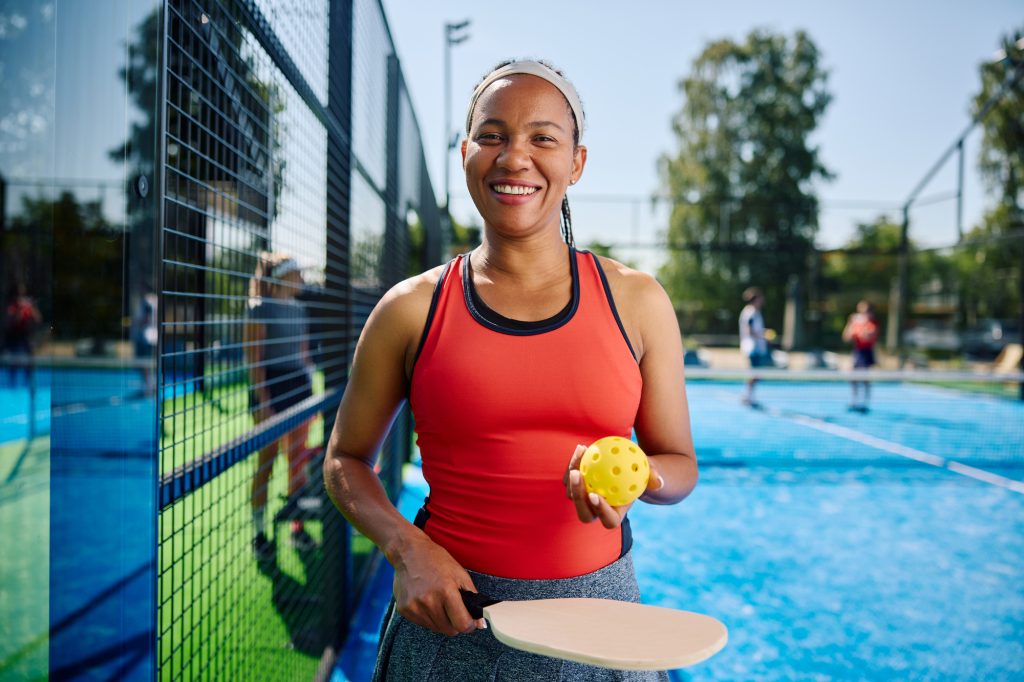Pickleball is more than just a fun social game; it’s a competitive sport where you aim to dominate the court. Mastering technique is crucial, but true power comes from strength. The key? A strength training program designed for pickleball players. Let’s explore how muscle-building exercises and proper conditioning can enhance your game.
Why Strength Training is Important in Pickleball
Practice is essential, but without muscle strength, you’ll struggle with power and agility. Strength training provides these key benefits:
- More Power: Stronger muscles lead to harder, faster shots.
- Better Endurance: Increased stamina helps you last through intense rallies.
- Fewer Injuries: Stronger muscles and joints keep you on the court longer.
Strength Training for Pickleball Explained
It’s not just about heavy lifting. You need to target the right muscle groups. Exercises should mimic on-court movements like lunging, jumping, rotating, and sprinting.
Bodyweight vs. Weighted Exercises
- Bodyweight: Great for beginners or those without equipment. Think squats, lunges, and push-ups.
- Weighted: Adds resistance for quicker strength gains. Dumbbells and kettlebells offer versatility.
Top 5 Strength Training Exercises for Pickleball Players
Here are the best exercises to boost power, endurance, and agility on the court.
- Split SquatsWhy it’s essential: Split squats build leg strength for low shots and quick direction changes.How to perform:
- Stand with one foot forward and the other back, about two feet apart.
- Hold a dumbbell in each hand.
- Bend your knees, lowering your body until your back knee hovers above the ground.
- Push back up to standing.
- Repeat on both legs.
Targeted muscles: Quadriceps, hamstrings, glutes, and core. Modification tips:
- Easier: Perform without weights or hold onto a chair for balance.
- Harder: Elevate the back foot on a bench for a Bulgarian split squat.
- Lawnmower RowsWhy it’s essential: This exercise strengthens your back and rotational muscles, mimicking a swing.How to perform:
- Assume a lunge stance with one hand on your front leg.
- Pick up a dumbbell with your free hand.
- Pull the dumbbell towards your waist, rotating slightly.
- Lower back to start.

Targeted muscles: Lats, traps, rhomboids, biceps, and obliques. Modification tips:
- Easier: Stabilize with a bench under your front knee and hand.
- Harder: Keep your front arm off your leg for extra core work.
- Goblet SquatsWhy it’s essential: Goblet squats build explosive leg power for quick movements.How to perform:
- Hold a kettlebell or dumbbell at chest level.
- Stand with feet shoulder-width apart.
- Squat down, keeping your chest up and weight centered.
- Return to standing.
Targeted muscles: Quadriceps, glutes, hamstrings, and core. Modification tips:
- Easier: Use a lighter weight or sit onto a chair.
- Harder: Hold a dumbbell in each hand or add a jump at the top.
- Dumbbell Chest PressWhy it’s essential: This exercise balances arm strength, preventing imbalances.How to perform:
- Lie on a bench holding dumbbells in each hand.
- Push the weights straight up until arms are extended.
- Lower the weights to chest level.
- Repeat.
Targeted muscles: Chest, shoulders, and triceps. Modification tips:
- Easier: Use lighter weights or fewer repetitions.
- Harder: Perform one arm at a time for core stability.
- Single-Leg DeadliftWhy it’s essential: This exercise improves balance and coordination.How to perform:
- Hold a dumbbell in one hand.
- Stand on the opposite leg, kicking the free leg backward.
- Lean forward, lowering the weight toward the ground.
- Return to standing.
- Switch sides.
Targeted muscles: Hamstrings, glutes, and lower back. Modification tips:
- Easier: Use a wall or chair for balance.
- Harder: Hold a weight in each hand.
Integrating Strength Training into Your Routine
Consistency is crucial for results. Here’s how to add these exercises to your routine:
- Frequency: Aim for 2–3 strength sessions per week.
- Rest Days: Alternate between strength training and pickleball to avoid injuries.
- Progression: Gradually increase weights or repetitions as you get stronger.
3 Major Benefits of Strength Training for Pickleball Players
- More Power: Generate more force in strokes and serves.
- Improved Stamina: Stay energized through long matches.
- Injury Prevention: Strengthen muscles and joints to reduce the risk of strains or sprains.
Conclusion
Pickleball success isn’t just about skill—it’s about strength. By integrating these targeted exercises into your routine, you’ll gain the power, agility, and endurance to outplay your opponents. Start small, stay consistent, and watch your game transform.
Check out our Facebook!
Frequently Asked Questions





